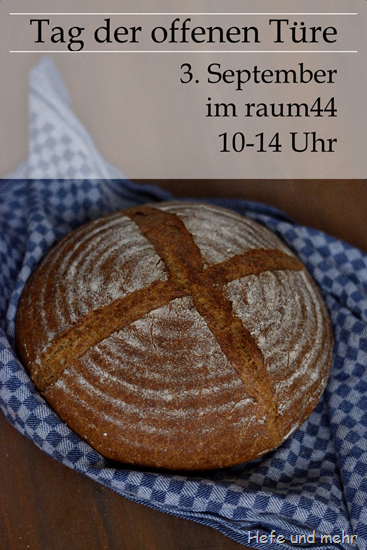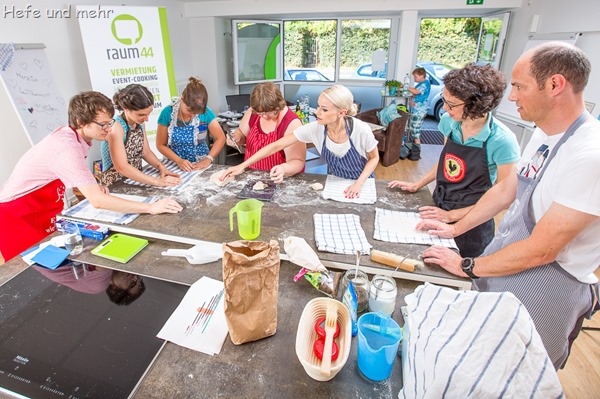 About 200 rolls made from about 12kg flour, that was the outcome of a sucessful bread baking day. The theme of the successful second bread baking course was “homemade rolls” and took place in “raum44”. I knew already from the first course that my time schedule was working properly but I was a bit nervous anyway. But as soon as the first cheerful participants arrived I relaxed as I realized that this was going to be great day!
About 200 rolls made from about 12kg flour, that was the outcome of a sucessful bread baking day. The theme of the successful second bread baking course was “homemade rolls” and took place in “raum44”. I knew already from the first course that my time schedule was working properly but I was a bit nervous anyway. But as soon as the first cheerful participants arrived I relaxed as I realized that this was going to be great day!
East Frisian Black Bread with Sunflower Seeds
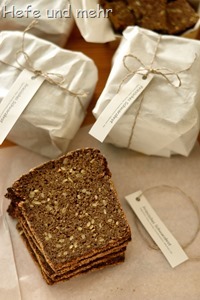 The very first suggestion I got for the post series “regional bread” was East Frisian Black Bread. As I already wrote a recipe for the magazine “Ö” I needed another variant – and decided to create a new recipe using sun flower seeds and coarse rye in a soaker. A bigger batch of sugar beet syrup makes the crumb darker and adds a subtle sweetness to the sour flavour notes from the sourdough.
The very first suggestion I got for the post series “regional bread” was East Frisian Black Bread. As I already wrote a recipe for the magazine “Ö” I needed another variant – and decided to create a new recipe using sun flower seeds and coarse rye in a soaker. A bigger batch of sugar beet syrup makes the crumb darker and adds a subtle sweetness to the sour flavour notes from the sourdough.
It is a very aromatic black bread, and the soaker helps to create a moist crumb. Cut in slices and wrapped in paper I took it with me to the food swap “Schwarzmarkt” in cologne. A attentive reader maybe already noticed that I used the food swap to bake a big batch of different rye breads. It was a good opportunity to bake a lot of rye breads without suffering from my sensibility to rye. and to provide you, my dear reader, a new batch of rye recipes. This is for me another advantage of this great Swap.
Onjeschwedde
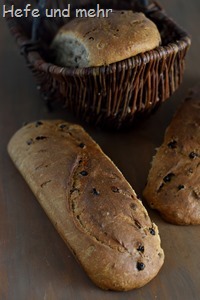 I’m totally thrilled about all the little jewels I meet in range of my “regional bread” series. From Annette I got describtion of the Bread Onjeschwedde, which is a raisin bread speciality of Rheydt – a part of Mönchengladbach. It is baked with the loaves touching each other a methode which keeps the bread very soft and moist. Before baking it is slashed with a curved long cut and some small cuts on the sides. The so called “Rheydter Flower”.
I’m totally thrilled about all the little jewels I meet in range of my “regional bread” series. From Annette I got describtion of the Bread Onjeschwedde, which is a raisin bread speciality of Rheydt – a part of Mönchengladbach. It is baked with the loaves touching each other a methode which keeps the bread very soft and moist. Before baking it is slashed with a curved long cut and some small cuts on the sides. The so called “Rheydter Flower”.
The name “onjeschwedde” means literally “not sweated” and means that the bread is made with “green” flour – freshly milled flour of newly harvest grains. This flour contains more moisture then a ripened flour which looses the moisture – it sweats! As it was just harvest time, so I called my local mill and ask. And indeed they promised me fresh flour for September.
The second special thing about this bread is that it is made with a huge amount of rye – 40% to be precise. It is the first sweet bread I met with this high amount rye! And so I used sourdough as preferment, which adds a deepness to its aroma, rounded by a faint cinnamon flavour. Sweetness comes from a bit of sugar and currants. The taste is something special, a sweet bread but with its very own, distinct flavour. A great bread which needs nothing more then a bit of butter!
Bread baking course for Beginners – A review
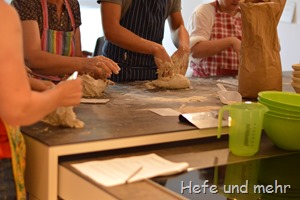 Done! The first two bread baking courses are lying behind us.
Done! The first two bread baking courses are lying behind us.
The subtitle of the course could be “Some like it hot”, too, as the summer came back with full power at the end of august. Even in the normaly cooler “Bergische Land” we reach temperatures above 30°C. Already at 10 o’clock it was hot, and the three ovens which were already running heated the room additionally. But that does not stop the participants – fearless they all dive into the dough.
Rheinisches Krustenbrot
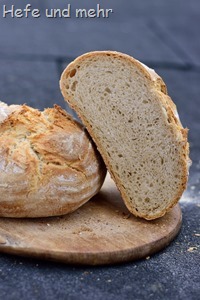 The second bread for my regional bread collection is one I know well: a crusty bread from the rhineland, called “Rheinisches Krustenbrot”.
The second bread for my regional bread collection is one I know well: a crusty bread from the rhineland, called “Rheinisches Krustenbrot”.
These crusty breads you can find in different parts of Germany and they vary in the amount of rye which is added to the dough. I know it as a mild bread with only 10% rye flour added. It is baked with seamside up which creates the typical rustic look of this bread. It has a light, fluffy crumb and – as the name suggested – a thick, crunchy crust.
I baked my version of this bread using two different sourdoughs: A rye sourdough which adds a hearty note to the flavour and which contains all of the rye in the formula, and a mild wheat sourdough which adds a joghurt like note to the taste of the bread.
Regensburger Kipferl
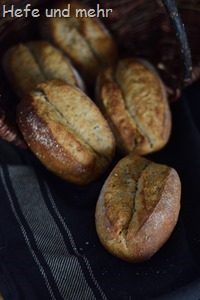 Finally I can post the first recipe in the upcoming post series of “regional breads” and can tell you how I came to this idea.
Finally I can post the first recipe in the upcoming post series of “regional breads” and can tell you how I came to this idea.
It all started with an email from the Magazine “Ö”, asking if I could develop some recipes form different German regions for their September issue. Of course I could and shortly after I was whirlwinding in the kitchen, baking Eastfrisian Blackbread, Schrippen from Berlin, Cologne Röggelchen, Göppinger Briegel, Swabian Spelt bread and Bavarian Farmers Bread. At the end of the week the bread was stacking in my kitchen and some colleagues and family members would find anonymous gifts of bread or rolls 🙂 I sent the recipe together with some Gerstl to the photographer who bake the bread, too and took the pictures.
Sourdough bread with 60% rye
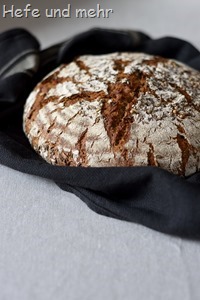 I was asked more than once to publish a sourdough rye bread recipe for the “Bread baking for Beginners” post series. I hesitated as a rye bread is not so easy to handle as a wheat one and to know when a pure sourdough loaf is ready to bake needs some experience. But with the Rye bread without sourdough we had already the right starting point to step into the world of sticky rye dough – practising this bread before switching to sourdough is highly advisable.
I was asked more than once to publish a sourdough rye bread recipe for the “Bread baking for Beginners” post series. I hesitated as a rye bread is not so easy to handle as a wheat one and to know when a pure sourdough loaf is ready to bake needs some experience. But with the Rye bread without sourdough we had already the right starting point to step into the world of sticky rye dough – practising this bread before switching to sourdough is highly advisable.
To rise the bread with only sourdough in a reliable way, the sourdough has to be very active. If it is not so active or was in the fridge for a longer period, making a refreshment to activate the sourdough yeast the day before is a must. The rye sourdough is then build in two stages to archive a well balance flavour and a high activity. The two stages make use of the fact that lactobacteria and yeast differ in their temperature optima. The first, cooler and firmer stage is perfect for the growth of bacteria , which produce lactic acid and acetic acid. The warm and soft stage then favours the yeasts which are needed for a good oven spring.
The recipe, which I created for this post contains 60% of rye and 40% of wheat flour which makes the dough sticky but still good to handle. It is a classical german “Roggenmischbrot” (literally mixed rye bread), with a slight sour and hearty flavour. Different bread spices which are sprinkled into the bread form add a spicy note to its taste.
Summer Squash Salsa
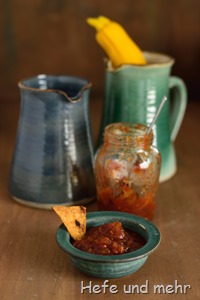 Some recipes have to be made in big batches as they are favourites. The summer squash salsa from Irmela Erckenbrechts cookbook “Zucchini” is a such a family favourite. It taste great as spread on fresh bread, as dip for nachos, as barbeque sauce or as fast dinner with pasta. And so we normally quadruple the amount given in the book directly.
Some recipes have to be made in big batches as they are favourites. The summer squash salsa from Irmela Erckenbrechts cookbook “Zucchini” is a such a family favourite. It taste great as spread on fresh bread, as dip for nachos, as barbeque sauce or as fast dinner with pasta. And so we normally quadruple the amount given in the book directly.
And last year, when the sister moved last summer we carried carefully the many, many glasses freshly made salsa down stairs of the old flat and up the stairs into the new one. And were rewarded at the end of the day with salsa and nachos – a story with happy end.
The recipe is great to use some of the giant summer squashes which had reached one kilo ore more, growing hided under leaves. I got some of these giants from a colleague and – of course – we cook salsa with them. And so Winter can come, we are stocked with 20 glasses salsa now 🙂
Spelt Mice
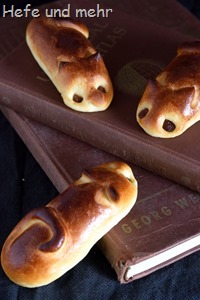 A reader told me about “Schulmäusen” (School mice), a small sweet roll filled with hazelnut praline. She tried to bake similar rolls in a spelt variant but struggled with them getting to dry. My brain worked a while on this idea in the background and came up with a recipe at the end – just in time for school start. As the name “Schulmaus” is a brand name, I decided to call my rolls Spelt mice and formed most of them like a mouse, too. But if you do not roll one end into a long tail, then you get the original form, too.
A reader told me about “Schulmäusen” (School mice), a small sweet roll filled with hazelnut praline. She tried to bake similar rolls in a spelt variant but struggled with them getting to dry. My brain worked a while on this idea in the background and came up with a recipe at the end – just in time for school start. As the name “Schulmaus” is a brand name, I decided to call my rolls Spelt mice and formed most of them like a mouse, too. But if you do not roll one end into a long tail, then you get the original form, too.
They are not a healthy snack, but a treat for small and big ones with a sweet tooth. The crumb is fluffy and the filling creamy – a good way to make school start a bit sweeter!

